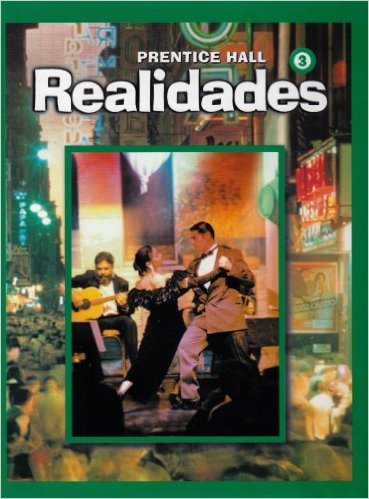
All Solutions
Page 230: Actividad 37
The demonstrative adjective agrees with the noun in number and gender. It comes always before the noun.
When a demonstrative adjective is used to replace a noun then it is called the demonstrative pronoun. The demonstrative pronouns have a written accent and adjectives don’t.
When describing something unidentified, we use the demonstrative pronouns “esto”, “eso” or “aquello. Note that these pronouns do not have an accent mark.
Since we have “lista” (the list) we know exactly about what we are talking about. Therefore, we will use the demonstrative adjective “esta”.
For the next one, we will also choose the demonstrative adjective “aquella” because we have “lista” as a noun in the sentence.
The demonstrative adjective agrees with the noun in number and gender. It comes always before the noun.
When a demonstrative adjective is used to replace a noun then it is called the demonstrative pronoun. The demonstrative pronouns have a written accent and adjectives don’t.
When describing something unidentified, we use the demonstrative pronouns “esto”, “eso” or “aquello. Note that these pronouns do not have an accent mark.
Since we have “los fondos” (the funds) we know exactly about what we are talking about. Therefore, we will use the demonstrative adjective “estos”.
For the next one, we will choose the demonstrative adjective “este” because the demonstrative adjective has to agree with the noun (mes) in number and gender.
The demonstrative adjective agrees with the noun in number and gender. It comes always before the noun.
When a demonstrative adjective is used to replace a noun then it is called the demonstrative pronoun. The demonstrative pronouns have a written accent and adjectives don’t.
When describing something unidentified, we use the demonstrative pronouns “esto”, “eso” or “aquello. Note that these pronouns do not have an accent mark.
Since we have “todo” (all) we will use the demonstrative adjective “aquello”.
The demonstrative adjective agrees with the noun in number and gender. It comes always before the noun.
When a demonstrative adjective is used to replace a noun then it is called the demonstrative pronoun. The demonstrative pronouns have a written accent and adjectives don’t.
When describing something unidentified, we use the demonstrative pronouns “esto”, “eso” or “aquello. Note that these pronouns do not have an accent mark.
Since we have “escritorio” (desk) we know exactly about what we are talking about. Therefore, we will use the demonstrative adjective “aquel”.
For the next one, we will choose the demonstrative pronoun “ése” because it is replacing the noun (escritorio).
The demonstrative adjective agrees with the noun in number and gender. It comes always before the noun.
When a demonstrative adjective is used to replace a noun then it is called the demonstrative pronoun. The demonstrative pronouns have a written accent and adjectives don’t.
When describing something unidentified, we use the demonstrative pronouns “esto”, “eso” or “aquello. Note that these pronouns do not have an accent mark.
Since we have “las donaciones” (the donations) we know exactly about what we are talking about. Therefore, we will use the demonstrative adjective “esas”.
The demonstrative adjective agrees with the noun in number and gender. It comes always before the noun.
When a demonstrative adjective is used to replace a noun then it is called the demonstrative pronoun. The demonstrative pronouns have a written accent and adjectives don’t.
When describing something unidentified, we use the demonstrative pronouns “esto”, “eso” or “aquello. Note that these pronouns do not have an accent mark.
Since we have “artículo” (the article) we will choose the demonstrative adjective “este” because it has to agree with the noun (el artículo) in number and gender.
The demonstrative adjective agrees with the noun in number and gender. It comes always before the noun.
When a demonstrative adjective is used to replace a noun then it is called the demonstrative pronoun. The demonstrative pronouns have a written accent and adjectives don’t.
When describing something unidentified, we use the demonstrative pronouns “esto”, “eso” or “aquello. Note that these pronouns do not have an accent mark.
Since we have “las plantas” (the plants) we will choose the demonstrative adjective “esas” because we already have the noun (plantas) in the sentence.
The demonstrative adjective agrees with the noun in number and gender. It comes always before the noun.
When a demonstrative adjective is used to replace a noun then it is called the demonstrative pronoun. The demonstrative pronouns have a written accent and adjectives don’t.
When describing something unidentified, we use the demonstrative pronouns “esto”, “eso” or “aquello. Note that these pronouns do not have an accent mark.
Since we have “el artículo” (the article) we will choose the demonstrative adjective “esto” because it has to agree with the noun (el artículo) in number and gender.
The demonstrative adjective agrees with the noun in number and gender. It comes always before the noun.
When a demonstrative adjective is used to replace a noun then it is called the demonstrative pronoun. The demonstrative pronouns have a written accent and adjectives don’t.
When describing something unidentified, we use the demonstrative pronouns “esto”, “eso” or “aquello. Note that these pronouns do not have an accent mark.
Since we have “páginas” (pages) we will choose the demonstrative adjective “esas” because we know exactly about what we are talking about.
For the next one, we will choose the demonstrative pronoun ” ésta” because it is replacing the noun (página).
The demonstrative adjective agrees with the noun in number and gender. It comes always before the noun.
When a demonstrative adjective is used to replace a noun then it is called the demonstrative pronoun. The demonstrative pronouns have a written accent and adjectives don’t.
When describing something unidentified, we use the demonstrative pronouns “esto”, “eso” or “aquello. Note that these pronouns do not have an accent mark.
Since we have “el informe” (the report) we will choose the demonstrative adjective “este” because we know exactly about what we are talking about.

